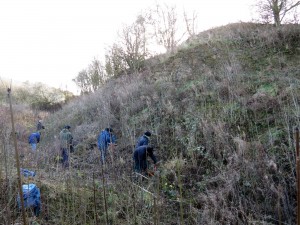Geoconservation Day, Saturday 30 January 2016
Beacon Hill Quarry, Sedgley.

Beacon Hill Quarry before clearance.
Photo by Mike Allen
Beacon Hill forms the northern end of a ridge, known as the Sedgley-Northfield Ridge, which forms a natural watershed for Central England. Rainfall to the north and east drains towards the River Trent and out to the North Sea, whilst rainfall to the west and south drains towards the River Severn and out of the Bristol Channel. The Hill is formed of a folded unit of Silurian Aymestry Limestone (part of the Ludlow Series) which is approximately 10 Ma younger than the Wenlock Series rocks seen at Wren’s Nest. The rocks are grey-brown in colour, thinly bedded and nodular with occasional bands of bentonite and muddy horizons. The limestone is also fossiliferous and contains many brachiopods and bivalves. This strata makes the site an important one for limestone grassland. It supports a variety of plants, including greater knapweed, carline thistle and bristly ox-tongue, whilst attracting rare butterflies like the brown and green hairstreak.
Beacon Hill Quarry after clearance.
Photo by Andy Harrison.
Gabriel pointed out that although Sedgley Beacon is owned by Dudley Council there are not the funds or personnel to keep someone on the site looking after it all the time. Therefore, the most the Council can do is to maintain access to the site and deal with any complaints. The BBC Wildlife Trust acts on behalf of the Council to maintain the site and is grateful for any voluntary help they receive.
